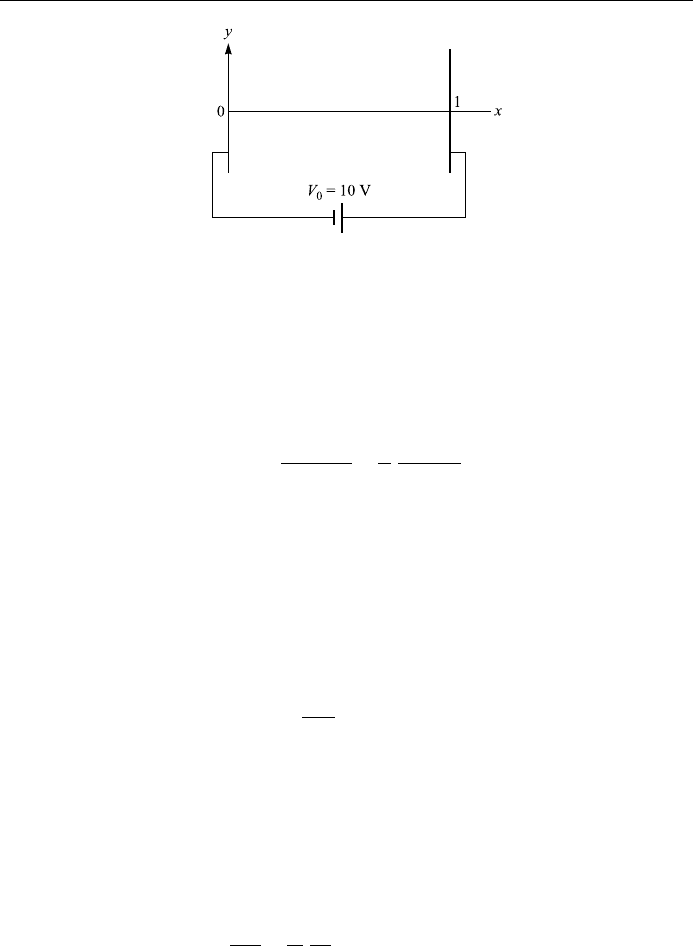Chow T.L. Mathematical Methods for Physicists: A Concise Introduction
Подождите немного. Документ загружается.


to transform the second term on the right hand side of Eq. (10.62) and obtain
rÿ
1
"
Z
Gr; r
0
r
0
dr
0
Z
r
0
r
0
Gr; r
0
ÿGr; r
0
r
0
r
0
dS
0
10:63
or
rÿ
1
"
Z
Gr; r
0
r
0
dr
0
Z
r
0
@
@n
0
Gr; r
0
ÿGr; r
0
@
@n
0
r
0
dS
0
; 10:64
where n
0
is the outward normal to dS
0
. The Green's function Gr; r
0
can be found
from Eq. (10.60) subject to the appropriate boundary conditions.
If the potential vanishes on the surface S
0
or @=@n
0
vanishes, Eq. (10.64)
reduces to
rÿ
1
"
Z
Gr; r
0
r
0
dr
0
: 10:65
On the other ha nd, if the surface S
0
encloses no charge, then Poisson's equation
reduces to Laplace's equation and Eq. (10.64) reduces to
r
Z
r
0
@
@n
0
Gr; r
0
ÿGr; r
0
@
@n
0
r
0
dS
0
: 10:66
The potential at a ®eld point r due to a point charge q located at the point r
0
is
r
1
4"
q
r ÿ r
0
jj
:
Now
r
2
1
r ÿ r
0
jj
ÿ4r ÿ r
0
(the proof is left as an exercise for the reader) and it follows that the Green's
function Gr; r
0
in this case is equal
Gr; r
0
1
4"
1
r ÿ r
0
jj
:
If the medium is bounded, the Green's function can be obtained by direct solution
of Eq. (10.60) subject to the appropriate boundary conditions.
To illustrate the procedure of the Green's function technique, let us consider a
simple example that can easily be solved by other methods. Consider two
grounded parallel conducting plates of in®nite extent: if the electric charge density
between the two plates is given, ®nd the electric potential distribution between
406
PARTIAL DIFFERENTIAL EQUATIONS

the plates. The electric potential distribution is described by solving Poisson's
equation
r
2
ÿ="
subject to the boundary conditions
(1) 00;
(2) 10:
We take the coo rdinates shown in Fig. 10.3. Poisson' s equation reduces to the
simple form
d
2
dx
2
ÿ
"
: 10:67
Instead of using the general result (10.64), it is more convenient to proceed
directly. Multiplying Eq. (10.67) by Gx; x
0
and integrating, we obtain
Z
1
0
G
d
2
dx
2
dx ÿ
Z
1
0
xG
"
dx: 10:68
Then using integration by parts gives
Z
1
0
G
d
2
dx
2
dx Gx; x
0
dx
dx
ÿ
ÿ
ÿ
ÿ
1
0
ÿ
Z
1
0
dG
dx
d
dx
dx
and using integration by parts again on the right hand side, we obtain
ÿ
Z
1
0
G
d
2
dx
2
dx ÿGx; x
0
dx
dx
1
0
dG
dx
1
0
ÿ
Z
1
0
d
2
G
dx
2
dx
ÿ
ÿ
ÿ
ÿ
ÿ
"#
ÿ
ÿ
ÿ
ÿ
ÿ
G0; x
0
d0
dx
ÿ G1; x
0
d1
dx
ÿ
Z
1
0
d
2
G
dx
2
dx:
407
SOLUTIONS OF POISSON'S EQUATION
Figure 10.3.

Substituting this into Eq. (10.68) we obtain
G0; x
0
d0
dx
ÿ G1; x
0
d1
dx
ÿ
Z
1
0
d
2
G
dx
2
dx
Z
1
0
Gx; x
0
x
"
dx
or
Z
1
0
d
2
G
dx
2
dx G1; x
0
d1
dx
ÿ G0; x
0
d0
dx
ÿ
Z
1
0
Gx; x
0
x
"
dx: 10:69
We must now choose a Green's function which satis®es the following equation
and the boundary cond itions:
d
2
G
dx
2
ÿx ÿ x
0
; G0; x
0
G1; x
0
0: 10:70
Combining these with Eq. (10.69) we ®nd the solution to be
x
0
Z
1
0
1
"
xGx; x
0
dx: 10:71
It remains to ®nd Gx; x
0
. By integration, we obtain from Eq. (10.70)
dG
dx
ÿ
Z
x ÿ x
0
dx a ÿUx ÿ x
0
a;
where U is the unit step function and a is an integration constant to be determined
later. Integrating once we get
Gx; x
0
ÿ
Z
Ux ÿ x
0
dx ax b ÿx ÿ x
0
Ux ÿ x
0
ax b:
Imposing the boundary conditions on this general solution yields two equations:
G0; x
0
x
0
Uÿx
0
a 0 b 0 0 b 0;
G1; x
0
ÿ1 ÿ x
0
U1 ÿ x
0
a b 0:
From these we ®nd
a 1 ÿ x
0
U1 ÿ x
0
; b 0
and the Green's function is
Gx; x
0
ÿx ÿ x
0
Ux ÿ x
0
1 ÿ x
0
x: 10:72
This gives the response at x
0
due to a unit source at x. Interchanging x and x
0
in
Eqs. (10.70) and (10.71) we ®nd the solut ion of Eq. (10.67) to be
x
Z
1
0
1
"
x
0
Gx
0
; xdx
0
Z
1
0
1
"
x
0
ÿx
0
ÿ xUx
0
ÿ x1 ÿ xx
0
dx
0
:
10:73
408
PARTIAL DIFFERENTIAL EQUATIONS

Note that the Green's function in the last equation can be written in the form
Gx; x
0
1 ÿ xxx< x
0
1 ÿ xx
0
x > x
0
(
:
Laplace transform solutions of boundary-value problems
Laplace and Fourier transforms are useful in solving a variety of partial diÿer-
ential equations, the choice of the appropriate transforms depends on the type of
boundary conditions imposed on the problem. To illustrate the use of the Lapace
transforms in solving boundary-value problems, we solve the following equation:
@u
@t
2
@
2
u
@x
2
; 10:74
u0; tu3; t0; u x; 010 sin 2x ÿ 6 sin 4x: 10:75
Taking the Laplace transform of Eq. (10.74) with respect to t gives
L
@u
@t
2L
@
2
u
@x
2
"#
:
Now
L
@u
@t
pL uÿux; 0
and
L
@
2
u
@x
2
"#
Z
1
0
e
ÿpt
@
2
u
@x
2
dt
@
2
@x
2
Z
1
0
e
ÿpt
ux; tdt
@
2
@x
2
Lu:
Here @
2
=@x
2
and
R
1
0
dt are interchangeable because x and t are independent.
For convenience, let
U Ux; pLux; t
Z
1
0
e
ÿpt
ux; tdt:
We then have
pU ÿ ux; 02
d
2
U
dx
2
;
from which we obtain, on using the given condition (10.75),
d
2
U
dx
2
ÿ
1
2
pU 3 sin 4x ÿ 5 sin 2x: 10:76
409
BOUNDARY-VALUE PROBLEMS

Now think of this as a diÿerential equation in terms of x,withp as a parame ter.
Then taking the Laplace transform of the given conditions u0 ; tu3; t0,
we have
Lu0; t 0; Lu3; t 0
or
U0; p0; U3; p0:
These are the boundary con ditions on Ux; p. Solving Eq. (10.76) subject to these
conditions we ®nd
Ux; p
5 sin 2x
p 16
2
ÿ
3 sin 4x
p 64
2
:
The solution to Eq. (10.74) can now be obtained by taking the inverse Laplace
transform
ux; tL
ÿ1
Ux; p 5e
ÿ16
2
t
sin 2x ÿ 3e
ÿ64
2
sin 4x:
The Fourier transform method was used in Chapter 4 for the solution of
ordinary linear ordinary diÿerential equations with constant coecients. It can
be extended to solve a variety of partial diÿerential equations. However, we shall
not discuss this here. Also, there are other methods for the solution of linear
partial diÿerential equations. In general, it is a dicult task to solve partial
diÿerential equations analytically, and very often a numerical method is the
best way of obtaining a solution that satis®es given boundary conditions.
Problems
10.1 (a) Show that yx; tF2x 5tG2x ÿ 5t is a general solution of
4
@
2
y
@t
2
25
@
2
y
@x
2
:
(b) Find a particular solution satisfying the conditions
y0; ty; t0; yx; 0sin 2x; y
0
x; 00:
10.2. State the nature of each of the following equations (that is, whether elliptic,
parabolic, or hyperbolic)
a
@
2
y
@t
2
@
2
y
@x
2
0; b x
@
2
u
@x
2
y
@
2
u
@y
2
3y
2
@u
@x
:
10.3 The electromagnetic wave equation: Classical electromagnetic theory was
worked out experimentally in bits and pieces by Coulomb, Oersted, Ampere,
Faraday and many others, but the man who put it all togeth er and built it
into the compact and consistent theory it is today was James Clerk Maxwell.
410
PARTIAL DIFFERENTIAL EQUATIONS

His work led to the understanding of electromagnetic radiation, of which
light is a special case.
Given the four Maxwell equations
rE ="
0
; Gauss' law;
rB
0
j "
0
@E=@tAmpere's law;
rB 0 Gauss' law;
rE ÿ@B=@t Faraday's law;
where B is the magnetic induction, j v is the current density, and
0
is the
permeability of the medium, show that:
(a) the electric ®eld and the magnetic induction can be expressed as
E ÿr ÿ @A=@t; B rA;
where A is called the vector potential, and the scalar potential. It
should be noted that E and B are invariant under the following trans-
formations:
A
0
A r;
0
ÿ @=@t
in which is an arbitrary real function. That is, both (A
0
;, and
(A
0
;
0
) yield the same E and B. Any condition which, for computa tional
convenience, restricts the form of A and is said to de®ne a gauge. Thus
the above transformation is called a gauge transformation and is
called a gauge parameter.
(b) If we impose the so-called Lorentz gauge condition on A and :
rA
0
"
0
@=@t0;
then both A and satisfy the following wave equations:
r
2
A ÿ
0
"
0
@
2
A
@t
2
ÿ
0
j;
r
2
ÿ
0
"
0
@
2
@t
2
ÿ="
0
:
10.4 Given Gauss' law
RR
S
E ds q=", ®nd the electric ®eld produced by a
charged plane of in®nite extension is given by E =", where is the charge
per unit area of the plane.
10.5 Consider an in®nitely long uncharged conducting cylinder of radius l placed
in an originally uniform electric ®eld E
0
directed at right angles to the axis of
the cylinder. Find the potential at a point > l from the axis of the cylin-
der. The boundary conditions are:
411
PROBLEMS

; '
ÿE
0
cos ' ÿE
0
x for !1;
0for l;
where the x-axis has been taken in the direction of the uniform ®eld E
0
.
10.6 Obtain the solution of the heat conduction equation
@
2
ux; t
@x
2
1
@ux; t
@t
which satis®es the bounda ry conditions
(1) u0; tul; t0; t 0; (2) ux; 0f x; 0 x, where f x is a
given function and l is a constant.
10.7 If a battery is connected to the plates as shown in Fig. 10.4, and if the charge
density distribution between the two plates is still given by x, ®nd the
potential distribution between the plates.
10.8 Find the Green's function that satis®es the equation
d
2
G
dx
2
x ÿ x
0
and the boundary conditions G 0 when x 0 and G remains bounded
when x approaches in®nity. (This Green's function is the potential due to a
surface charge ÿ" per unit area on a plane of in®nite extent located at x x
0
in a dielectric medium of permittivity " when a grounded conducting plane
of in®nite extent is located at x 0.)
10.9 Solve by Laplace transforms the boundary-value problem
@
2
u
@x
2
1
K
@u
@t
for x > 0; t > 0;
given that u u
0
(a constant) on x 0 for t > 0, and u 0 for x > 0; t 0.
412
PARTIAL DIFFERENTIAL EQUATIONS
Figure 10.4.

11
Simple linear integral equations
In previous chapters we have met equations in which the unknown functions
appear under an integral sign. Such equations are called integral equations.
Fourier and Laplace transforms are important integral equations, In Chapter 4,
by introducing the method of Green's function we were led in a natural way to
reformulate the problem in terms of integral equations. Integral equations have
become one of the very useful and sometimes indispensable mathematical tools of
theoretical physics and engineering.
Classi®cation of linear integral equations
In this chapter we shall con®ne our attention to linear integral equations. Linear
integral equations can be divided into two major groups:
(1) If the unknown function occurs only under the integral sign, the integral
equation is said to be of the ®rst kind. Integral equations having the
unknown function both inside and outside the integral sign are of the second
kind.
(2) If the limits of integration are constants, the equation is called a Fredholm
integral equation. If one limit is variable, it is a Volterra equation.
These four kinds of linear integral equations can be written as follows:
f x
Z
b
a
Kx; tutdt Fredholm equation of the first kind; 11:1
uxf x
Z
b
a
Kx; tutdt Fredholm equation of the second kind;
11:2
413

f x
Z
x
a
Kx; tu t dt Volterra equation of the first kin d; 11:3
uxf x
Z
x
a
Kx; tutdt Volterra equation of the second kind:
11:4
In each case ut is the unknown function, K x; t and f x are assumed to be
known. Kx; t is called the kernel or nucleus of the integral equation. is a
parameter, which often plays the role of an eigenvalue. The equation is said to
be homogen eous if f x0.
If one or both of the limits of integration are in®nite, or the kernel Kx; t
becomes in®nite in the range of integration, the equation is said to be singular;
special techniques are required for its solut ion.
The general linear integral equation may be written as
hxuxf x
Z
b
a
Kx; tutdt: 11:5
If hx0, we have a Fredholm equation of the ®rst kind; if hx1, we have a
Fredholm equation of the second kind. We have a Volterra equatio n when the
upper limit is x.
It is beyond the scope of this book to present the purely mathematical general
theory of these various types of equations. After a general discussion of a few
methods of solution, we will illustrate them with some simple examples. We will
then show with a few examples from physical problems how to convert diÿerential
equations into integral equations.
Some methods of solution
Separable kernel
When the two variables x and t which appear in the kernel Kx; t are separable,
the problem of solving a Fr edholm equation can be reduced to that of solving a
system of algebraic equations, a much easier task. When the kernel Kx; t can be
written as
Kx; t
X
n
i1
g
i
xh
i
t; 11:6
where gx is a function of x only and ht a function of t only, it is said to be
degenerate. Putting Eq. (11.6) into Eq. (11.2), we obtain
uxf x
X
n
i1
Z
b
a
g
i
xh
i
tutdt:
414
SIMPLE LINEAR INTEGRAL EQUATIONS

Note that gx is a constant as far as the t integration is concerned, hence it may
be taken outside the integral sign and we have
uxf x
X
n
i1
g
i
x
Z
b
a
h
i
tutdt: 11:7
Now
Z
b
a
h
i
tutdt C
i
const:: 11:8
Substituting this into Eq. (11.7) and solving for ut, we obtain
utf xC
X
n
i1
g
i
x: 11:9
The value of C
i
may now be obtained by substituting Eq. (11.9) into Eq. (11.8).
The solution is only valid for certa in values of , and we call these the eigenvalues
of the integral equation. The homogeneous equation has non-trivial solutions
only if is one of these eigenvalues; these solutions are called eigenf unctions of
the kernel (operator) K.
Example 11.1
As an example of this method, we consider the following equation:
uxx
Z
1
0
xt
2
x
2
tutdt: 11:10
This is a Fredholm equation of the second kind, with f xx and
Kx; txt
2
x
2
t. If we de®ne
Z
1
0
t
2
utdt;ÿ
Z
1
0
tutdt; 11:11
then Eq. (11.10) becomes
uxx x ÿx
2
: 11:12
To determine A and B, we put Eq. (11.12) back into Eq. (11.11) and obtain
1
4
1
4
1
5
ÿ; ÿ
1
3
1
3
1
4
ÿ: 11:13
Solving this for and ÿ we ®nd
60
240 ÿ 120 ÿ
2
;ÿ
80
240 ÿ 120 ÿ
2
;
and the ®nal solution is
ut
240 ÿ 60x 80x
2
240 ÿ 120 ÿ
2
:
415
SOME METHODS OF SOLUTION
